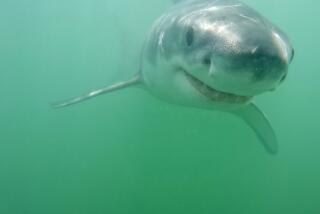Great white sharks swim among us at Southern California beaches
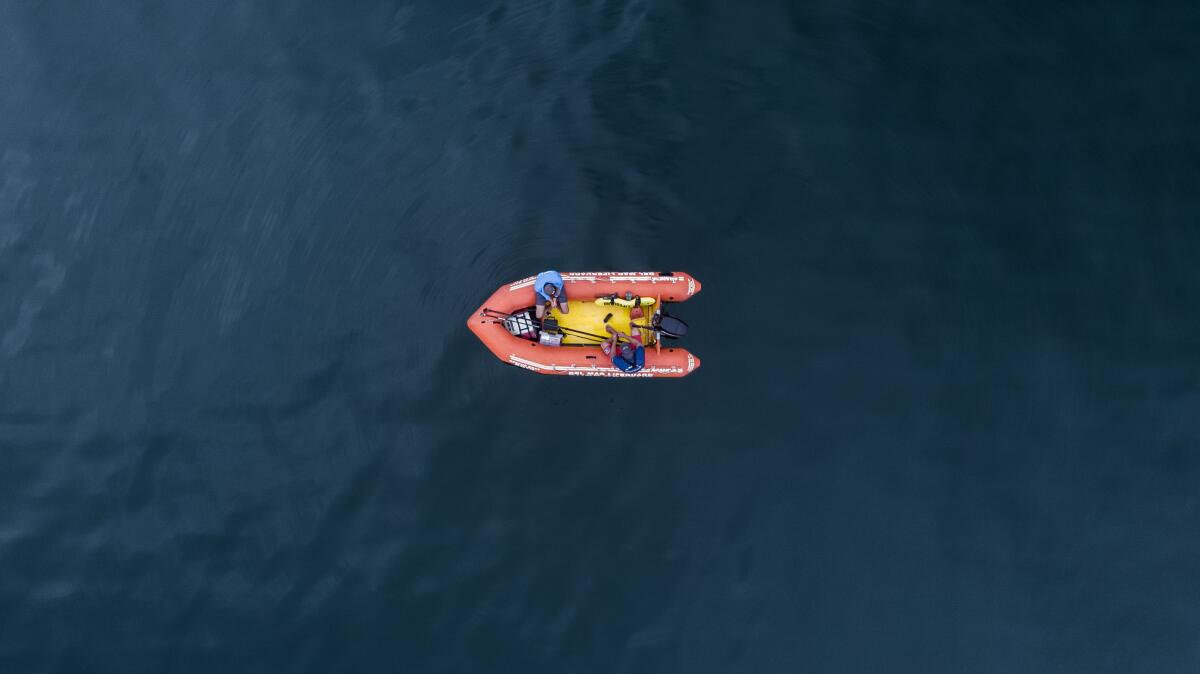
SAN DIEGO — On a recent cloudy morning, shark researchers from Cal State Long Beach followed a young white shark as it wound its way along the shore off Del Mar in San Diego County.
Using a drone to spot the animal and an inflatable boat to follow it, they traced the shark’s path across the rocky reef as it darted past surfers.
For the record:
6:56 p.m. Aug. 3, 2020An earlier version of this article said there had been 14 fatal shark attacks off the Pacific coast since 2000. There have been six since 2000 and 14 since 1900.
The footage they captured didn’t represent a rare appearance of the ocean predator among beachgoers, but an everyday occurrence on the Southern California coastline. White sharks, known popularly as great whites, are regular visitors that share the sea with us daily, new studies are finding.
Classic horror films notwithstanding, juvenile white sharks glide every day among surfers, swimmers and paddle-boarders, generally without incident.
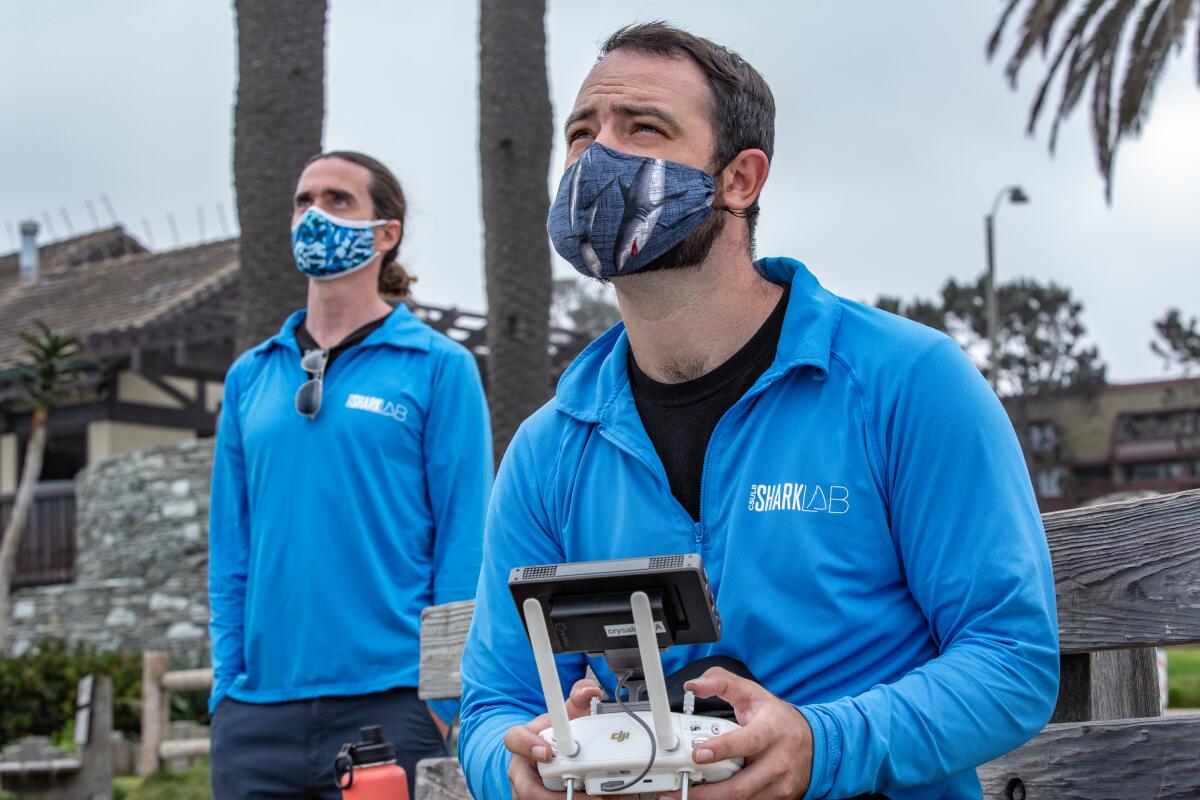
“There are lots of sharks out there this summer, and people are in and amongst them, not getting bitten,” said Chris Lowe, professor and director of the Cal State Long Beach Shark Lab.
When bites do happen, they can be catastrophic, such as the fatal attack on Solana Beach triathlete Dave Martin in 2008, or the life-threatening leg injury that swimmer Leeanne Ericson sustained off San Onofre in 2017. The Shark Research Committee, a nonprofit group that tracks shark activity on the West Coast, has documented more than 100 shark attacks on the Pacific coast since 2000, including six fatalities.
Lowe and his team are studying when and where white sharks appear and what circumstances lead to attacks to improve beach safety. The team is measuring temperature, prey availability and other environmental factors, along with human activity in the ocean. They’re working closely with lifeguards at Southern California beaches to analyze how people use the water, and what happens during white shark interactions.
“Our goal is to learn more about the patterns, so we can predict where and when they’ll show up,” Lowe said. “So by working with lifeguards, they can make decisions on when to post signs, when to close beaches if they show up. And then we can get that out to the public so they can modify their behavior if necessary.”
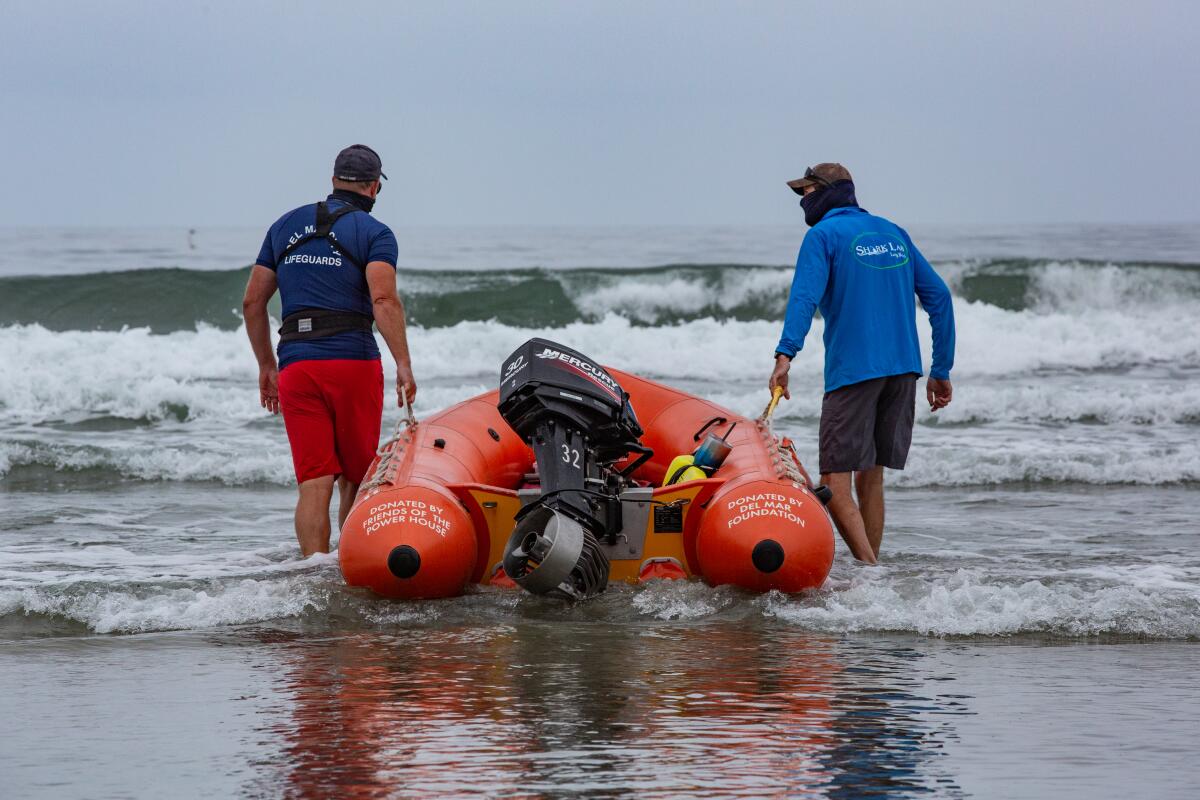
The team has been tagging white sharks at beaches along the coast of Southern California, using acoustic transmitters that record their movements. So far this year, they have tagged about 30, most of them off Ventura and Santa Barbara, some off the central coast and just one at Del Mar.
White sharks congregate at hot spots including Santa Barbara, Ventura, Santa Monica Bay, the Long Beach-Huntington Beach area and the San Clemente-San Onofre area, said Patrick Rex, a graduate student at the Shark Lab. Those change from year to year; recently, there have been large aggregations off Santa Barbara, and fewer in San Diego, possibly because of red tide events, he said.
Researchers have installed buoys that record the tag transmissions. They collect the data monthly and share with the lifeguards, Lowe said. The team has also developed a buoy with a real-time sensor that will alert lifeguards and scientists by text each time a white shark swims by.
In addition, they use drone surveys to record sharks as they move among people in the water.
“We look at how many sharks are in close proximity to people, and we also look at how sharks behave when they’re close to people,” Lowe said.
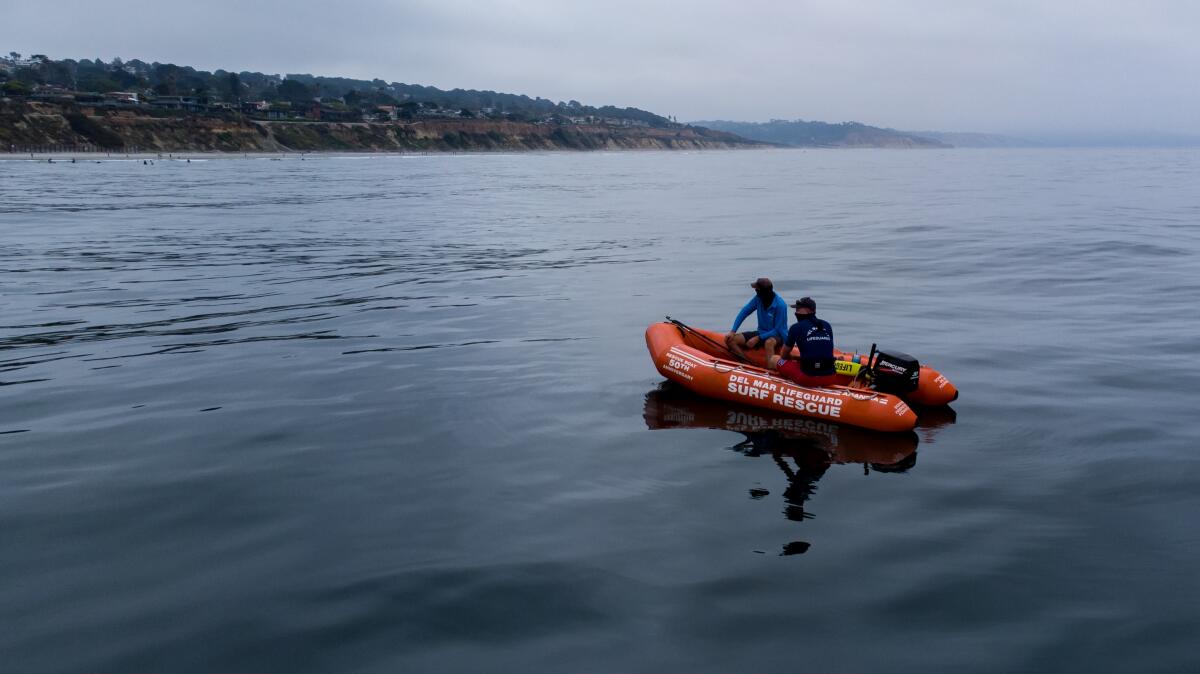
Most sharks found off Southern California aren’t behemoths like those featured on “Shark Week” or the massive female shark known as “Deep Blue,” recorded on video off Guadalupe Island in Mexico. White sharks can grow to 20 feet or more, according to a NOAA species profile, and live up to 70 years, Lowe said.
Those close to shore, however, are typically juveniles ranging from newborn to several years old: “babies” or “toddler sharks,” as researchers Rex and James Anderson of Shark Lab refer to them.
The young sharks are usually about 4 to 9 feet long, they said, and probably seek shallow waters for heat, food and protection. Sharks are cold-blooded and rely on the environment to maintain their body temperature. So younger ones, with smaller body mass, gravitate to warmer water. That’s also a better bet for juvenile sharks that haven’t yet learned to hunt marine mammals.
“The most abundant food source and easiest for them to catch is stingrays,” Lowe said. “We have lots of stingrays in our water.”
They may also select shallow water to avoid adult white sharks, which will eat their young. Given that, the young sharks are often hungry and skittish.
That’s what the researchers saw last week as they searched for sharks off Del Mar. Rex flew the drone in long transects off the coast, looking for sharks in the surf, while Anderson communicated with colleagues on the boat to alert them to any sightings.
Surfers lined up along the low waves, distance swimmers paddled to an outer buoy, and kids splashed at the water’s edge. For several hours, Rex piloted a drone over the site, seeking a quick, dark shape in the surf. Dolphins surfaced in the waves, and sea lions worked the line behind the breakers, hunting for fish. Rex paid close attention to that zone; the sharks often follow the same route just beyond the crashing waves.
Just after 10:30 a.m., he spotted a small white shark. It was about 6 feet long, he said, and tough to follow as it swam over dark patches of reef that camouflaged its shape. Anderson alerted the boat, which headed to meet it. Just as they reached the spot, the drone began losing power, and Rex brought it in to replace the battery.
He returned it to the site and scouted out the shark again while the boat crew readied a fishing spear fitted with an acoustic tag. For the next 20 minutes, the boat and shark played a game of chase behind the surf line, with the animal veering away each time the crew approached. Surfers didn’t appear to notice the race taking place nearby, and almost certainly couldn’t see the shark deep below the surface.
That’s a scene that takes place routinely along the Southern California coast, where beachgoers unwittingly swim alongside white sharks.
“We’re one year into a two-year study, and during summer, as we had seen from our tagging data, people are in the water near these white sharks quite often and they don’t know it,” Lowe said.
So what turns a passing encounter into an attack? That’s what Lowe and his team hope to learn.
Sheer numbers are part of the equation. As Southern California’s population has grown, so has beach visitation, which means more people in the ocean with sharks. Beach use estimates often include cars in the parking lots, or rough head counts on the shore. But there aren’t good figures for people in the water, Lowe said. Drone surveys will help quantify that.
Sharks, too, appear to be more numerous. Researchers don’t have the kind of hard numbers they would get for species that are fished commercially, but there are indications the white shark population is growing, said Heidi Dewar, a marine biologist for the National Oceanic and Atmospheric Administration. Tighter regulations on fisheries have reduced bycatch of sharks in nets, and marine mammals such as sea lions have recovered, increasing food resources for adult white sharks.
Anecdotal sightings of white sharks have surged in recent years, and photo identification surveys have confirmed more sharks at Guadalupe Island, she said. In a recent paper on shark populations, she estimated there were about 3,000 white sharks in the Pacific Ocean off North America.
“It’s scary to think of white sharks being out there,” she said, “but it actually means that we’re making good choices from a marine management perspective, and the population is recovering.”
What does this mean for humans? Potentially fewer stingrays, for one thing, as young sharks gobble them up. Might we also be meals for hungry sharks?

“We’re definitely not on their menu,” Lowe said. “We know that. That is well-determined globally. We know that people are occasionally bitten. And one of the theories is they mistake us for prey. Another idea is they might bite when they’re threatened, to defend themselves.”
Through drone flights, Lowe, Rex and colleagues are counting the number of surfers, swimmers, stand-up paddleboarders, boogie-boarders and waders, to analyze and predict encounters with sharks.
“So far, what we’ve seen is the sharks don’t really care,” Rex said. “They don’t pay attention to people. Unless the person gets too close, and then they usually just startle and swim away. We have not documented any aggressive behavior from a juvenile white shark to a person.”
The juvenile white shark they followed Wednesday appeared to follow that playbook, evading researchers for hours while they tried unsuccessfully to track and tag it.
“Unfortunately, it was a combination of a shark that didn’t want to get close — young sharks like that are just pretty skittish — and just bad conditions,” Rex said. “This one just did not want to play ball.”
Brennan writes for the San Diego Union-Tribune.
More to Read
Sign up for Essential California
The most important California stories and recommendations in your inbox every morning.
You may occasionally receive promotional content from the Los Angeles Times.


